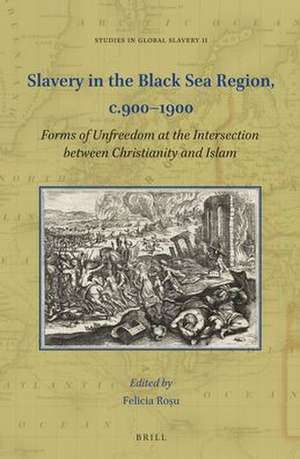Slavery in the Black Sea Region, c.900–1900: Forms of Unfreedom at the Intersection between Christianity and Islam: Studies in Global Slavery, cartea 11
Felicia Roşuen Limba Engleză Paperback – 30 mai 2023
Contributors are: Viorel Achim, Michel Balard, Hannah Barker, Andrzej Gliwa, Colin Heywood, Sergei Pavlovich Karpov, Mikhail Kizilov, Dariusz Kołodziejczyk, Maryna Kravets, Natalia Królikowska-Jedlińska, Sandra Origone, Victor Ostapchuk, Daphne Penna, Felicia Roșu, and Ehud R. Toledano.
Preț: 350.01 lei
Nou
Puncte Express: 525
Preț estimativ în valută:
66.97€ • 70.11$ • 55.42£
66.97€ • 70.11$ • 55.42£
Carte indisponibilă temporar
Doresc să fiu notificat când acest titlu va fi disponibil:
Se trimite...
Preluare comenzi: 021 569.72.76
Specificații
ISBN-13: 9789004549265
ISBN-10: 9004549269
Pagini: 448
Dimensiuni: 155 x 235 mm
Greutate: 0 kg
Editura: Brill
Colecția Brill
Seria Studies in Global Slavery
ISBN-10: 9004549269
Pagini: 448
Dimensiuni: 155 x 235 mm
Greutate: 0 kg
Editura: Brill
Colecția Brill
Seria Studies in Global Slavery
Notă biografică
Felicia Roșu, Ph.D. (2009), Georgetown University, is a Lecturer in History at Leiden University. Her publications include Elective Monarchy in Transylvania and Poland-Lithuania, 1569-1587 (Oxford University Press, 2017) and Critical Readings on Global Slavery (Brill, 2017), co-edited with Damian Alan Pargas.
Cuprins
List of Figures
Notes on Contributors
Acknowledgements
Preface
Ehud R. Toledano
Introduction
Felicia Roșu
Part I: The Italian Phase
1. Black Sea Slavery in Genoese Notarial Sources, 13th–15th Centuries
Michel Balard
2. Slavery in the Black Sea Region in Venetian Notarial Sources, 14th–15th Centuries
Sergei Karpov
Part II: Slavery and Christianity
3. The Role of Slaves in the Byzantine Economy, 10th–11th Centuries: Legal Aspects
Daphne Penna
4. Christian Slave Traders, Slave Owners, and Slaves in the 13th–15th Centuries
Sandra Origone
5. The Orthodox Church and the Emancipation of Gypsy Slaves in the Romanian Principalities in the 19th Century
Viorel Achim
Part III: Raiders and Captives on the Northern Shore
6. “It Was the Poles that Gave Me Most Pain”: Polish Slaves and Captives in the Crimea, 1475–1774
Mikhail Kizilov
7. How Captives Were Taken: The Making of Tatar Slaving Raids in the Early Modern Period
Andrzej Gliwa
8. Captive-Taking in the Ottoman and Crimean Black Sea Region and Unfreedom in the Northern Countries
Maryna Kravets and Victor Ostapchuk
Part IV: The Circassian Question
9. What Caused the 14th-Century Tatar–Circassian Shift?
Hannah Barker
10. Slaves of the Crimean Khan or Muslim Warriors? The Status of Circassians in the Early Modern Period
Natalia Królikowska-Jedlińska
Part V: The Black Sea and Global Slavery
11. People-Taking across the Mediterranean Maritime Frontier, 1675–1714
Colin Heywood
12. Slavery and the Slave Trade in the Atlantic and the Black Sea: A Comparative View
Dariusz Kołodziejczyk
Index
Notes on Contributors
Acknowledgements
Preface
Ehud R. Toledano
Introduction
Felicia Roșu
Part I: The Italian Phase
1. Black Sea Slavery in Genoese Notarial Sources, 13th–15th Centuries
Michel Balard
2. Slavery in the Black Sea Region in Venetian Notarial Sources, 14th–15th Centuries
Sergei Karpov
Part II: Slavery and Christianity
3. The Role of Slaves in the Byzantine Economy, 10th–11th Centuries: Legal Aspects
Daphne Penna
4. Christian Slave Traders, Slave Owners, and Slaves in the 13th–15th Centuries
Sandra Origone
5. The Orthodox Church and the Emancipation of Gypsy Slaves in the Romanian Principalities in the 19th Century
Viorel Achim
Part III: Raiders and Captives on the Northern Shore
6. “It Was the Poles that Gave Me Most Pain”: Polish Slaves and Captives in the Crimea, 1475–1774
Mikhail Kizilov
7. How Captives Were Taken: The Making of Tatar Slaving Raids in the Early Modern Period
Andrzej Gliwa
8. Captive-Taking in the Ottoman and Crimean Black Sea Region and Unfreedom in the Northern Countries
Maryna Kravets and Victor Ostapchuk
Part IV: The Circassian Question
9. What Caused the 14th-Century Tatar–Circassian Shift?
Hannah Barker
10. Slaves of the Crimean Khan or Muslim Warriors? The Status of Circassians in the Early Modern Period
Natalia Królikowska-Jedlińska
Part V: The Black Sea and Global Slavery
11. People-Taking across the Mediterranean Maritime Frontier, 1675–1714
Colin Heywood
12. Slavery and the Slave Trade in the Atlantic and the Black Sea: A Comparative View
Dariusz Kołodziejczyk
Index














